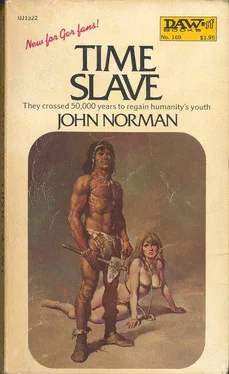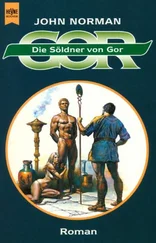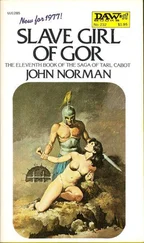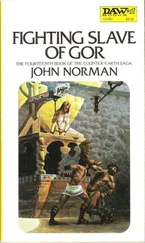John Norman - Time Slave
Здесь есть возможность читать онлайн «John Norman - Time Slave» весь текст электронной книги совершенно бесплатно (целиком полную версию без сокращений). В некоторых случаях можно слушать аудио, скачать через торрент в формате fb2 и присутствует краткое содержание. Город: New York, Год выпуска: 1975, ISBN: 1975, Издательство: DAW Books, Жанр: Альтернативная история, на английском языке. Описание произведения, (предисловие) а так же отзывы посетителей доступны на портале библиотеки ЛибКат.
- Название:Time Slave
- Автор:
- Издательство:DAW Books
- Жанр:
- Год:1975
- Город:New York
- ISBN:978-0879972042
- Рейтинг книги:3 / 5. Голосов: 1
-
Избранное:Добавить в избранное
- Отзывы:
-
Ваша оценка:
- 60
- 1
- 2
- 3
- 4
- 5
Time Slave: краткое содержание, описание и аннотация
Предлагаем к чтению аннотацию, описание, краткое содержание или предисловие (зависит от того, что написал сам автор книги «Time Slave»). Если вы не нашли необходимую информацию о книге — напишите в комментариях, мы постараемся отыскать её.
This was the directive that brought a dedicated group of scientists to device a means od sending one of their number back into the OLD STONE AGE when the great hunters of the Cro-Magnon days ripped the world away from the Neanderthals and their savage clan rivals.
Time Slave — читать онлайн бесплатно полную книгу (весь текст) целиком
Ниже представлен текст книги, разбитый по страницам. Система сохранения места последней прочитанной страницы, позволяет с удобством читать онлайн бесплатно книгу «Time Slave», без необходимости каждый раз заново искать на чём Вы остановились. Поставьте закладку, и сможете в любой момент перейти на страницу, на которой закончили чтение.
Интервал:
Закладка:
She opened her eyes, lowered her hands.
“Look,” said William.
The light was gone from the cubicle. It now seemed heavy, silent, very empty.
“There is nothing,” she whispered.
“No,” said William, “you are mistaken.”
“What do you mean?” she whispered.
“P is now present,” said William. “It is in the cubicle. The cubicle is now open.”
Hamilton looked at the cubicle, the heavy, sliding plastic panel. The cubicle was closed.
“It is closed,” said Hamilton.
“No,” said William. “The cubicle is open.”
Hamilton looked into the cubicle. It seemed very quiet now, absolutely still. The energies of P, asserted to be present, she knew, would not be, if they existed, in the visible or tactual spectrum. They could not be heard. They could not be seen. They could not be tasted, or smelled or touched.
“Such energies cannot exist,” she had once said to Herjellsen.
“Gravitation,” had said Herjellsen, “too, cannot be heard, nor can it be seen, or touched, or smelled or tasted, and yet it commands the motions of material bodies; it balances universes, plays with planets and guides meteors; does it not exist?”
“Of course,” had said Hamilton. “We know it does. We can see its effects.”
“And so, too,” bad said Herjellsen, “can one see the effects of P.”
Hamilton stared into the cubicle.
“It’s closed,” she whispered. “It’s closed.”
“No,” said William. “The cubicle is now open.”
Hamilton regarded the cubicle. It was three hundred and forty-three cubic feet in content, seven feet in height, width and depth, but, if William were correct, it was unfathomed in depth in another dimension. Hamilton wondered how deep was it? It was closed to three dimensions. She could see that. But, if William, and Gunther, and Herjellsen were correct, it was open to another.
“It’s there!” cried William. “It’s there!”
Hamilton screamed.
In the center of the cubicle, on the floor, was a small, heavy-wire cage, about a foot wide, a foot high and two feet in length. There was straw in the bottom of the cage, and a pan of water. Hamilton saw it was a trap, that had been sprung shut. It must have been baited. Inside, peering out through the cage wire, its eyes bright, was a large rodent.
Hamilton slipped to the floor, unconscious.
3
Gunther turned the Land Rover abruptly from the graveled road onto the plain.
Hamilton, pleased, sat between Gunther and William. It was the first time she had been permitted out of the compound since her arrival.
She, too, was now excited about Herjellsen’s work. The identification had not yet been made on the animal in the cage.
When she had learned that Gunther and William were to take the Land Rover and seek another animal, a live specimen, wild, for the third series of experiments, she had begged Herjellsen to be permitted to accompany them.
“Of course, Doctor Hamilton,” Herjellsen had readily agreed.
Hamilton had been frightened that he would refuse. She had been incredibly relieved, elated, at the readiness with which he had acceded to her request.
How marvelous it was to be outside the compound, away from the high, wire fence, the small, plain, severe buildings, of stucco and tin, the watching eyes of the armed blacks.
The Land Rover churned dust from the plain, in a stream of debris cast into the air behind it.
Gunther, his eyes narrowed, drove swiftly, too swiftly for the terrain.
Hamilton did not mind. It gave her a sense of release. She sensed the air pressed aside by the passage of the vehicle, sensed the dirt, spitting away, beneath the tread of the heavy sand tires.
On the graveled road, which passed not more than a half mile from the compound, which lay concealed from the road, the three of them had talked. William, as always, was affable. Gunther, as he usually was, was tight-upped, taciturn. Neither man wore a hat. A bag of water was slung to the right-hand door handle.
Hamilton had been permitted to come with the men. Herjellsen had willingly acceded to her request. She was fully fledged now, a member of the team.
The computer runs she had conducted on Herjellsen’s modified 1180, from data furnished by William, she had not completely understood, but she knew that they were integral to the development of the experimental sequence.
On the road, away from the compound, the men had spoken more openly with her about Herjellsen’s work, particularly William. Gunther, too, had commented from time to time. And when addressed, he responded to her questions, carefully, exactly. Hamilton leaned back. She was pleased. She was out of the compound. She could speak with the men alone, with Herjellsen not present. They seemed more communicative outside of the compound. Within the compound, they were less willing to speak freely. Though Herjellsen himself was commonly pleasant, and congenial, he tended, without meaning to, to dominate any group of which he was a member. When he was present, there was always the waiting to hear what he would say. It was not only Herjellsen’s ponderousness, his erudition, his brilliance which tended to cause him to loom among his colleagues, but also the imponderables of age and experience; he was in his late fifties; and, too, that he was their head, the leader, the determiner of action, the employer. Perhaps most simply there was the fact that he was Herjellsen, short, incisive, powerful, dominating. To him even Gunther, like a young, powerful liegeman, deferred. It was pleasant then for the hour, or afternoon, to be beyond the wire of the compound. Gunther, Hamilton and William were young. They were more of an age, were more commonly equal, and had more in common with one another than any of them might have had with Herjellsen. It was pleasant to be apart from him, his experience, his weightiness, the innocent oppressiveness of his maturity, his dominance. The three of them were young, and were now alone together, Herjellsen left behind. And, too, though she did not perhaps fully realize it, it was pleasant for another reason, for Hamilton, to be with the younger men. She sat between them, one with them, talking, with closeness. She felt very pleased to be with them, male colleagues. She did not fully understand her feelings. Perhaps it was simply the relief of being out of the compound, beyond the wire. She looked at Gunther. Suddenly he looked at her, too. Startled, she looked forward again, out the jolting, dusty, insect-stained windshield. His attention was again on his driving. If William were not present, and Gunther began to make love to her, she felt she would be unable to resist him. Gunther would not ask her if he might make love to her; he would simply begin. And she knew she would be unable to resist him. She fantasized his hands opening her shirt, unhooking her brassiere, freeing her slacks from her body, his hands then at her thighs, lifting her legs, putting her on her back across the front seat of the rover, half stripped. She knew she would be unable to resist him.
But she put such thoughts from her mind. She was a colleague, not a woman.
“I still suspect Herjellsen is a charlatan,” said William.
“It is possible,” said Gunther.
“Yet-the artifact,” said William. “It seems genuine.”
William referred to the piece of stone, spoken of by them as the Herjellsen artifact.
It was commonly kept in the computer building. Hamilton had seen it many times.
The artifact was rounded, chipped, roughly polished; it weighed 2.1 kilograms. Anthropologists would have referred to it as a tool. It was a weapon.
The artifact was the most surprising result of the first series of experiments. There had been many abortive experiments, many failures, many disappointments, in the first series. But in the first series, bit by bit, rudimentary translation techniques, relevant to testing the Herjellsen conjecture, had been conceived, developed and refined. The first object to appear in the translation cubicle, two months before Hamilton had been employed, was a piece of broken branch, seared and splintered as though torn from its tree by claws of fire. It had appeared in the cubicle blasted and smoking. The radiocarbon dating on the branch, conducted by Gunther, indicated the branch, though of an unknown wood, was contemporary. This was as it should have been. The branch had been living, had been torn from a living tree. Other results, in the beginning, were similar, though the objects collected were generally simple stones, sometimes pebbles, or chips. Most appeared stained, some half fused and glazed. Toward the end of the first series Herjellsen had, with the aid of William and Gunther, considerably refined his techniques. One of the major difficulties to be surmounted in the practical application of the Herjellsen conjecture was the coordination of diverse terms in appropriate binary combinations; many such combinations yielded nothing; one had destroyed a generator; Herjellsen spoke often of interphenomenal translation, namely, the translation of an object from one phenomenal dimension to another; speaking phenomenally, one might have said from one time and place to another; two pairs of values were stipulated, those of the translation cubicle in a compound in Rhodesia and a given time, sidereal scale, for its longitude at the moment of projected translation; the other two values, the crucial binary combinations, coordinated with the space and time of the cubicle, presented fantastic difficulties; the mind of Herjellsen was like the hand of a blind man reaching out in a dark room of incredible dimension; generally it would close on nothing; but then, once, suddenly, blasted and smoking on the floor of the cubicle had lain a branch, torn as though by fire from a tree; the hand had closed on something; this was the first successful set of coordinates; Herjellsen, with William, had studied them intensely, noting parameters and matrices, resemblances and divergencies. They had been computerized and examined from more than two hundred aspects. They were repeated, but this time yielded nothing.
Читать дальшеИнтервал:
Закладка:
Похожие книги на «Time Slave»
Представляем Вашему вниманию похожие книги на «Time Slave» списком для выбора. Мы отобрали схожую по названию и смыслу литературу в надежде предоставить читателям больше вариантов отыскать новые, интересные, ещё непрочитанные произведения.
Обсуждение, отзывы о книге «Time Slave» и просто собственные мнения читателей. Оставьте ваши комментарии, напишите, что Вы думаете о произведении, его смысле или главных героях. Укажите что конкретно понравилось, а что нет, и почему Вы так считаете.












